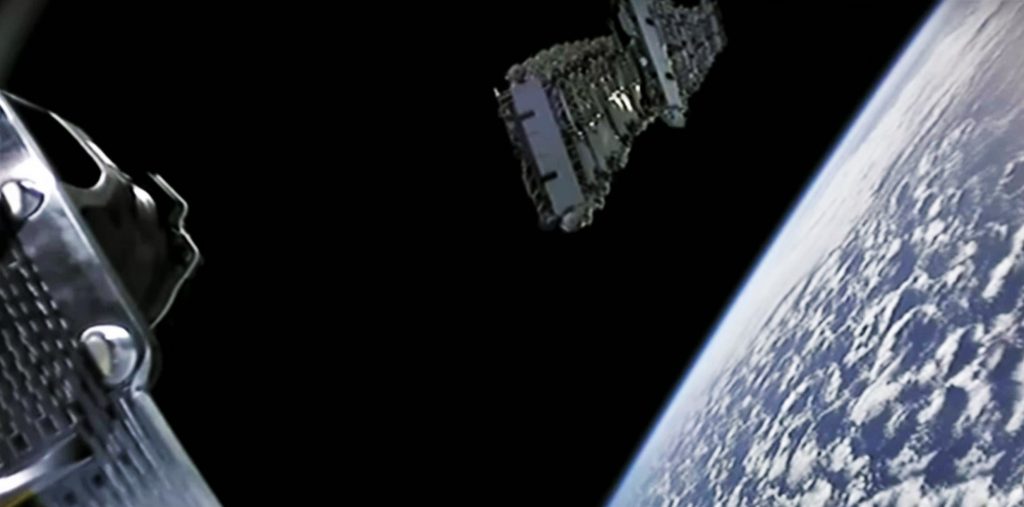According to SpaceX and customer Planet, the company will start offering Starlink rideshare launch opportunities as early as next month, opening up space for other companies, space agencies, and individuals to get their payloads into space.
SpaceX’s decision to co-opt its own Starlink missions as a vehicle for rideshare payloads is perhaps one of the most interesting strategic moves in the smallsat launch ecosystem in awhile. Announced in early-August 2019, SpaceX’s Smallsat Rideshare Program effectively marked the company’s entrance into the burgeoning smallsat launch services industry. Rather than the launch industry proper, the services industry focuses on finding ways to put tiny satellites on rockets that would normally be far too large to serve as a practical solution. By finding multiple customers and wrangling with their different schedules, spacecraft, and requirements, dozens of smallsats can be launched in such a way that it’s actually worth a large launch provider’s focus.
In the past, SpaceX famously worked with Spaceflight to launch the SSO-A mission in December 2018, using all of a Falcon 9 rocket’s performance to place 64 small satellites in orbit. After many, many delays and numerous planned customers still missing the launch, both Spaceflight and SpaceX came away with the conclusion that a fully dedicated smallsat launch at the scale of Falcon 9 was simply not a practical approach to the problem. Instead, spreading the ~120 satellites originally manifested on SSO-A over 3-6 smaller missions would be far more sustainable for all parties involved. With SpaceX’s Starlink rideshare strategy, the company may have done exactly that.
Each weighing about 115 kg (~250 lb) each and standing roughly the same size as a large mini-fridge, Planet has broken the news that three of its SkySat imaging satellites will fly on SpaceX’s ninth dedicated Starlink launch. Known as Starlink-8 in reference to it being the eighth launch of finalized v1.0 satellites, the mission is scheduled to launch no earlier than June, likely 3-4 weeks after SpaceX’s 8th Starlink launch (NET May 17).
After Starlink-8, Planet will include another three SkySats on an unspecified Starlink mission, also scheduled to launch sometime in Q3. Once complete, the earth imaging company’s fleet of high-resolution (~0.5m/px) observation satellites will be 21 strong,


Until SpaceX or its rideshare customers choose to release photos or offer up details, it remains unclear how the company’s Starlink rideshares will work from a technical perspective. Thanks to SpaceX’s extremely unique method of stacking and deploying each batch of 60 Starlink satellites, there will be a combination of challenges and benefits to grapple with. Because of Starlink’s flat, rectangular satellite design, a lot of space inside the Falcon payload fairing they occupy is left empty.

There’s a slight possibility that smaller satellites and their deployers could fit in the triangular gaps left at the bottom of Starlink stacks, but it’s unlikely that Planet’s relatively large (on the scale of smallsats) SkySats would fit in the constrained space. That leaves the large conical section left unused at the top of each Starlink-dedicated payload fairing. Given that SpaceX spins up Falcon 9’s upper stage and releases Starlink satellites like a deck of giant ~260 kg (~570 lb) cards, it’s highly unlikely that rideshare passengers could be deployed after the main Starlink deployment event.

That leaves some kind of solution that mounts rideshare payloads on top of the stack of satellites. The most likely solution would involve somehow attaching a satellite deployment mechanism to the tensioning rods that hold the Starlink stack together and are ejected to release all 60 spacecraft at once. If that solution is possible, Falcon 9 could deploy rideshare payloads, spin up, discard the structural rods and deployers in one go, and eject all 60 Starlink satellites with having to tweak any of the spacecraft or change launch operations much at all. Regardless, it will be interesting to see how SpaceX has solved its unique deployment problem.




Nice post
ReplyDelete